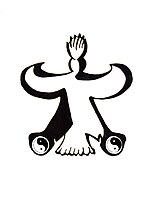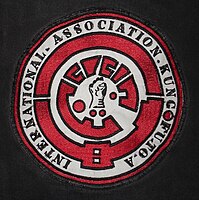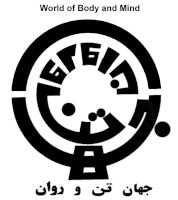Kung Fu To'A
Kung Fu To'A is a Persian martial art that was developed by Ibrahim Mirzaii in the 1960s. The term Kung Fu To'A is made up of the Chinese Kung Fu (here: martial arts ) and the old Persian To'A ( come with me ). Kung Fu To'A is the most practiced martial art in Iran today and has around 200,000 practitioners there.
The system of Kung Fu To'A consists of about 73,000 techniques, combinations and reactions. Above all, it impresses with its dynamic undulating movements and strong accentuation of the techniques, which often end powerfully with a twist.
Historical
Kung Fu To'A was developed by Ibrahim Mirzaii in Iran in the 1960s and is based on the basic principles of traditional Asian martial arts.
Mirzaii was very interested in martial arts from a young age. Shah Reza Pahlavi financed Mirzaii a trip through Asia to acquire various martial arts and to develop a new style from this knowledge. His journey formed the basis for the Kung Fu To'A he created.
The Shah was overthrown during the Iranian Revolution in 1978/1979. Kung Fu To'A was banned in Iran from then on. Many continued to train in secret, others fled abroad during the revolution. This is how this style spread worldwide over the years. A few years after the revolution, Mirzaii survived an assassination attempt, after which he fled abroad. The current whereabouts of Grand Master Mirzaii are still unknown. He himself distanced himself from Kung Fu To'A and created new styles called Kun Kafu Tawan and Pa Zar Bal based on To'A. He took the view that Kung Fu To'A should no longer be taught, whereupon some Kung Fu To'A masters distanced themselves from Mirzaii.
Today there are Kung Fu To'A schools (also called "temples") all over the world, including Germany, Italy, Portugal, Turkey and Canada. A few years ago this style was legalized again in Iran, where it continues to enjoy wide acceptance. Nevertheless, Kung Fu To'A is still one of the more unknown styles of Kung Fu. Through numerous feature films z. B. Shaolin Kung Fu is much more widely known.
The seven forms
There are seven forms in Kung Fu To'A. Instead of “form”, the term “kata” or “line” is also common in other martial arts. A form corresponds to a rehearsed sequence of movements, composed of many different techniques used for defense and attack. Each of these forms is examined by at least one master. If the student passes an exam, he or she receives a stripe on his kung fu jacket.
All seven forms deal with a certain philosophical topic beyond the physical aspect.
- Ana-To'A
- Ata-do
- Su-To
- Sam-sama-E
- Maya-Na
-
Ku-An-Na & West Maya-Na
- The sixth level of Kung Fu To'A consists of two forms: Ku-An-Na and West Maya-Na (West Mayana is also called "West Ai").
- Wei-Ma-Bato
The green belt is officially awarded after reaching the seventh level. After passing the master's examination, you can wear a red Kung Fu training jacket. Originally, other unarmed forms were planned beyond the seventh form, which should build on the previous ones. Of these extended forms, however, due to the historical events (ban on Kung Fu To'A, attack on Mirzaii), only "Ana-To'A sabz" (also called green or brown Ana-To'A) is officially handed down. Since these extensions of the To'A system were not completed starting with Ana-To'A sabz, Wei-Ma-Bato can be regarded as a conclusion. Therefore, some schools have agreed to award the black belt after reaching the seventh grade.
In addition to the unarmed forms, there are two traditional forms of weapons: Sai and Re-Key-Ma ( samurai sword ).
belt
The belt is made of red fabric and has a wide colored stripe in the middle. Depending on the degree of the student, this median can take on the colors white, green, brown or black.
The colors are based on the life of a tree:
the student begins with a white belt - white as a seed in the earth from which a tree is to grow. The second belt is green - like the sprout that germinates from the seed, drifts out of the ground and grows towards the sun. The third belt is brown - like the trunk of a full-grown tree that defies storms. The last belt is black - like a withered tree that is still not dead: it carries within it its knowledge, its wisdom and its experiences from its life. If one day it passes and becomes part of the soil from which it grew again, it passes on its experience as food to the younger trees in its vicinity and thus does not completely disappear.
philosophy
Kung Fu is the world of movement, movement of mightiness, movement of beauty, movement of absolute justice and humanity, movement to the health of society, Kung Fu is a movement to pure thought, the secret of which lies in the language of the soul. This means the way of the heart, i.e. H. the (re) discovery of the pure knowledge that we already carry within us. Kung Fu To'A goes this way through the “gate” of the body. With the help of the powerful movement of Kung Fu it is about gaining the courage and strength to let go of the known and familiar, to get to know yourself anew and to recognize the entire spectrum of your own soul.
Another supportive way to this self-knowledge is through meditation. Meditation serves to purify the mind, free from thoughts to increase presence and to deal with the ego.
In Kung Fu To'A it is said that one can only lose the struggle of life. What is meant is not dying, but that our life can be wasted if we cannot find the courage to embark on the path of the heart.
One finds an analogy to the path of the pure heart and to the teachings of the seven forms of Kung Fu To'A in Persian literature in “Bird Conversations” by Fariduddin Attar.
Bird talks - the Simorgh
The Bird Conversations ("Manteq-ot-teir") by Fariduddin Attar is a Persian story about how thousands of birds set out on a journey through seven valleys to find the Simorgh - the bird king. The seven valleys include the valley of desire (giving up possession), the valley of love (abandoning learned values such as “good” and “bad” and feeling the pure feeling of love), the valley of knowledge (breaking out of familiarity and Recognizing the connection between body and mind), the valley of self-sufficiency (giving up knowledge and the heart and searching for new things), the valley of unity (recognizing that everything in our world is interconnected), the valley of consternation (opens various Perspectives on being or non-being, one recognizes one's mortality and at the same time one's immortality) and lastly the valley of death (attaining immortality by accepting to become part of the whole). Each of the seven valleys is a hurdle and teaches the birds something about themselves and about which of their characteristics they have to leave behind in order to reach the Simorgh.
Of all the birds that set off, only 30 ultimately reach their destination and when they get there, they recognize that they are the Simorgh themselves.
The term Simorgh is made up of the Persian words for "thirty" (si) and "birds" (murgh).
symbolism
The most common symbols in Kung Fu To'A include images of a falcon with open wings. This could have its origin in a story about the Simorgh, in which it is said that the Simorgh would spread the seeds of the tree of life all over the world with the beat of its wings. In addition, hawks are considered extremely vigilant and astute. She is characterized by her eyesight, hunting skills, grace and power in flying.
"The falcon teaches us control over speed and movement, and it teaches us patience. It symbolizes recognizing opportunities and timely action. It shows us that we must be fully committed if we are to achieve the greatest possible success stands for leadership, prudence, prudence. It stands for a quick, graceful and agile mind and for how we can use our mental abilities more effectively to "grasp" with more patience what we need and desire most. "
- The following pictures show the most common signs of Kung Fu To'A.
techniques
If you want to use shock (strong accentuation at the end of the movement) in your techniques, you don't have to be particularly strong. By turning a technique, maximum power is transferred to the opponent through speed and precision.
In addition, you learn to let techniques flow into each other: you use the energy of your own last technique or the energy of your opponent and invest it in your own subsequent technique. You have to master this especially in the higher forms, as these are very long and they can only be mastered with the correct use of dynamics and a good breathing technique.
Individual evidence
- ↑ The History of the Iranian Martial Art Kungfu To'a (English). Archived from the original on March 7, 2012 ; accessed on March 9, 2018 .
- ↑ Kung Fu To'A - The Falcon. Retrieved July 13, 2015 .
Web links
literature
- Karate Budo Journal, edition unknown, article "Kung-Fu ToA - From the infinity of the universe", p. 57 ff.
- Martial Arts International, issue 05/03, article "Kung Fu Toa - Persian Kung-Fu", pp. 16-20.




